Ever since my friend became obsessed with Mama Inca’s ceviche three weeks ago, we have been visiting the Peruvian joint every Friday for it’s mouth-watering, tangy cured raw fish dish.
And I’ve willingly gone along because the ceviche is just that good. Only available on Fridays and Saturdays, or by ordering a day in advance, it is a perfectly refreshing way to end a long work week.
Hidden in a quiet street parallel to Fuxing S Road (復興南路), Mama Inca is a splash of vibrant colors in an otherwise drab neighborhood, with a bright red facade and an interior of rich oranges, blues and purples. The quaint atmosphere falls somewhere between the other two Peruvian joints in Taipei that I’ve been to: Polleria, a hole in the wall eatery, and Pico Pico, a fancy restaurant.
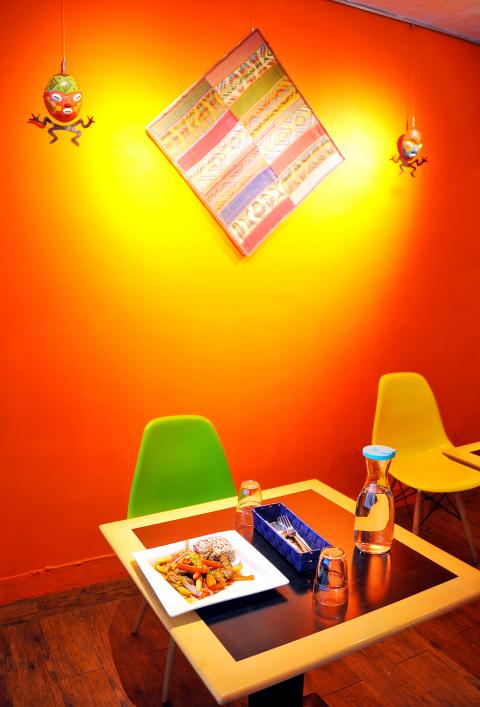
Photo: Han Cheung, Taipei Times
The restaurant is run by a Peruvian and Taiwanese couple who met in Cusco, with the Peruvian husband in charge of the cooking. The country’s cuisine is an amalgamation of various influences, ranging from indigenous to Spanish to Chinese. Some of the most common Peruvian dishes are relatively modern creations by immigrants: the ubiquitous pollo a la brasa, or chargrilled chicken, was developed in the 1950s by two men from Switzerland, while lomo saltado is a beef fusion dish created by Chinese immigrants at the turn of the 20th century. These are the two entrees we order.
The drinks menu is Peruvian as can be, including chicha morada, a sweet purple corn drink (NT$120); lemon juice with egg white (NT$120); Peruvian coffee (NT$120), pisco sour, the national cocktail (NT$200) and the country’s distinctive bright yellow-colored Inca Kola (NT$120). There’s also a chia seed (a “superfood” originating from Peru) lemonade (NT$140).
Even though I no longer drink soda, I feel compelled to order the Inca Kola for a nostalgic trip back to my time in South America. I never made it to Peru, but its cuisine was popular in Argentina where I resided. We also order the chicha morada.
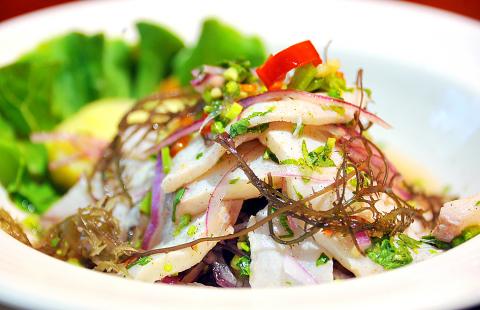
Photo: Han Cheung, Taipei Times
Created by a British resident in 1935, Inca Kola is another immigrant concoction turned national sensation. The taste is difficult to describe — very sweet and fruity, it falls somewhere between Coca Cola and cream soda. The distinctive ingredient is lemon verbena, a versatile plant native to Peru often used as a citrusy garnish in meat dishes, salad dressings and drinks.
The chicha morada is even more puzzling, having little corn taste, instead resembling flat cola or grape soda, with diced apple chunks floating on the top. The owner tells us that they added pineapple and lemon juice to a prepackaged chicha mix since the type of corn is difficult to obtain. I’m probably biased because I am not fond of overly sweet drinks, but it was not my favorite.
The meals come with a basic salad and soup with rice and quinoa. The ceviche (varies by market price, we paid NT$430) came first as an appetizer. Cured in lemon juice with a healthy serving of cilantro and onions, the first bite is very sour but in a light and refreshing way. The dish can be prepared with a number of seafood ingredients, but the star at Mama Inca is the cobia fish, which is firm and chewy. Sweet potatoes are added to balance the sourness, and the mushy texture adds an appealing dimension to the dish. It’s a great palate opener, even though it’s more expensive than the entrees.
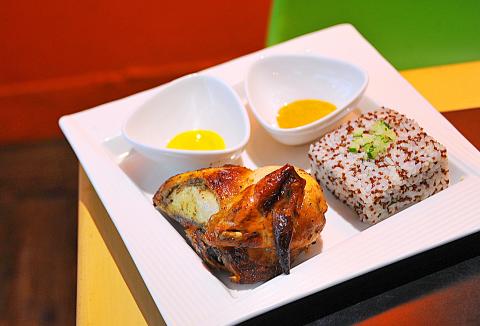
Photo: Han Cheung, Taipei Times
My friend ordered the lomo saltado (NT$300), stir-fried beef in a soy-and-vinegar based sauce with onions, tomatoes, bell peppers and french fries. The thinly-sliced beef is tender and juicy and the tomatoes and bell peppers provide the crunch and tang. But the most satisfying element were the french fries. Despite soaking in the sauce, the fries retained their crispiness, creating a sensation much like the American chili cheese version, but less thick. It came with a mixture of rice and quinoa, which has a crunchier texture than just plain rice.
I ordered the pollo a la brasa (quarter chicken for NT$200), which is served with the same rice and quinoa mixture and two dipping sauces — mustard and a spicy mayonnaise-like concoction.
The chicken was flavorful, grilled in typical Peruvian fashion. The outside was well-done with a savory layer of skin, but the inside was a bit dry without enough sauce to eat it with. Overall, the flavors paired well with the rice and quinoa, but it would have been better if the meat was juicier.
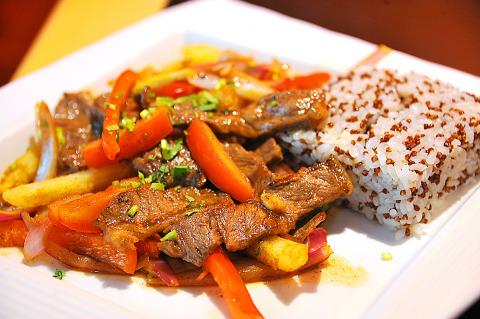
Photo: Han Cheung, Taipei Times
My friend wants to go again this week, and I plan on trying the aji de gallina (NT$340), which is shredded chicken with sauce made with peppers, walnuts and milk. And this time, she wants an entire ceviche portion to herself.
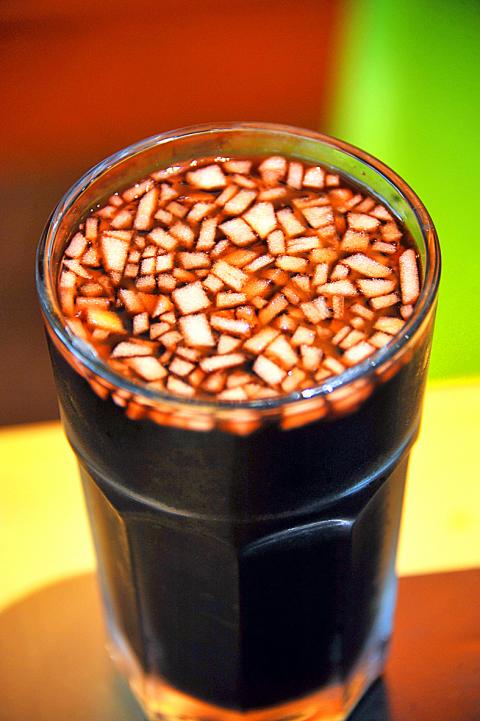
Photo: Han Cheung, Taipei Times

Many people noticed the flood of pro-China propaganda across a number of venues in recent weeks that looks like a coordinated assault on US Taiwan policy. It does look like an effort intended to influence the US before the meeting between US President Donald Trump and Chinese dictator Xi Jinping (習近平) over the weekend. Jennifer Kavanagh’s piece in the New York Times in September appears to be the opening strike of the current campaign. She followed up last week in the Lowy Interpreter, blaming the US for causing the PRC to escalate in the Philippines and Taiwan, saying that as

Taiwan can often feel woefully behind on global trends, from fashion to food, and influences can sometimes feel like the last on the metaphorical bandwagon. In the West, suddenly every burger is being smashed and honey has become “hot” and we’re all drinking orange wine. But it took a good while for a smash burger in Taipei to come across my radar. For the uninitiated, a smash burger is, well, a normal burger patty but smashed flat. Originally, I didn’t understand. Surely the best part of a burger is the thick patty with all the juiciness of the beef, the

This year’s Miss Universe in Thailand has been marred by ugly drama, with allegations of an insult to a beauty queen’s intellect, a walkout by pageant contestants and a tearful tantrum by the host. More than 120 women from across the world have gathered in Thailand, vying to be crowned Miss Universe in a contest considered one of the “big four” of global beauty pageants. But the runup has been dominated by the off-stage antics of the coiffed contestants and their Thai hosts, escalating into a feminist firestorm drawing the attention of Mexico’s president. On Tuesday, Mexican delegate Fatima Bosch staged a

Would you eat lab-grown chocolate? I requested a sample from California Cultured, a Sacramento-based company. Its chocolate, not yet commercially available, is made with techniques that have previously been used to synthesize other bioactive products like certain plant-derived pharmaceuticals for commercial sale. A few days later, it arrives. The morsel, barely bigger than a coffee bean, is supposed to be the flavor equivalent of a 70 percent to 80 percent dark chocolate. I tear open its sealed packet and a chocolatey aroma escapes — so far, so good. I pop it in my mouth. Slightly waxy and distinctly bitter, it boasts those bright,